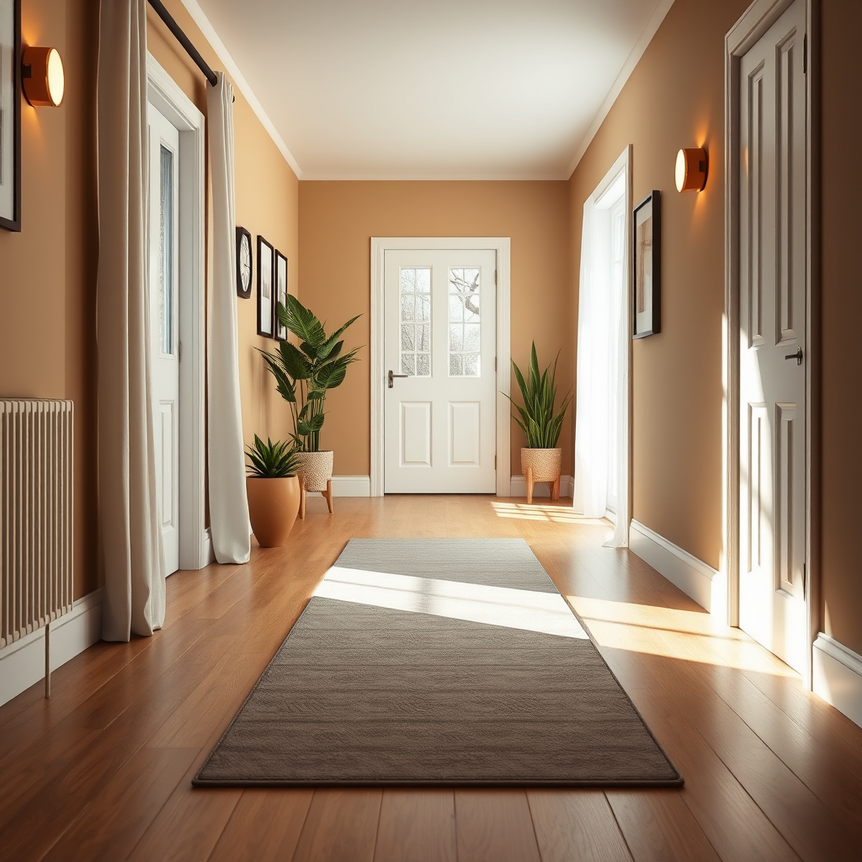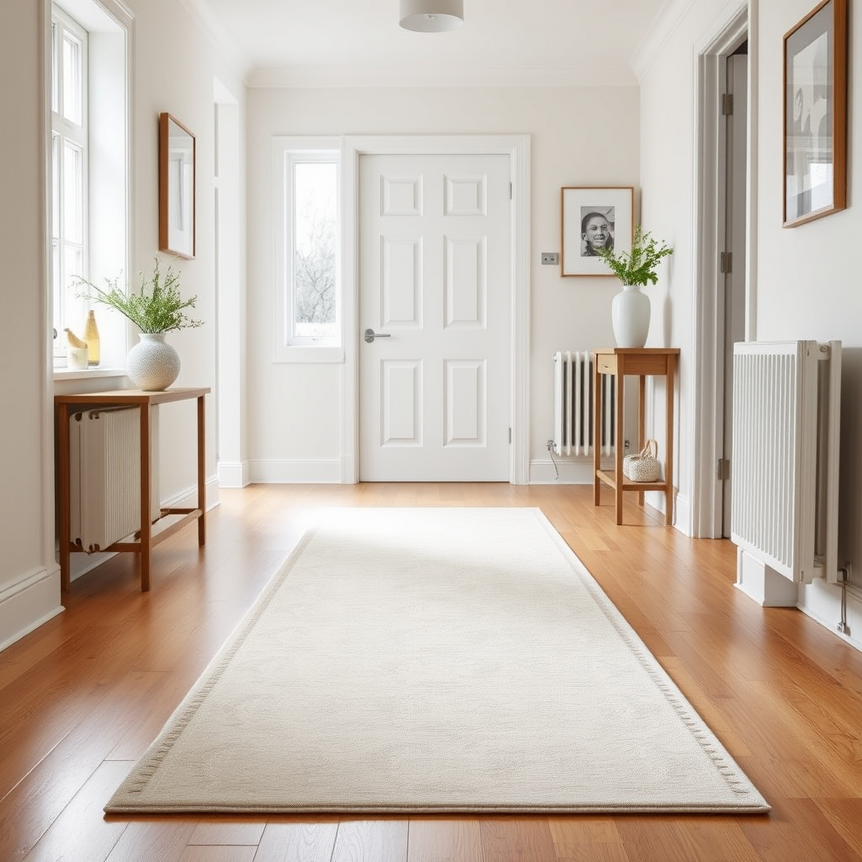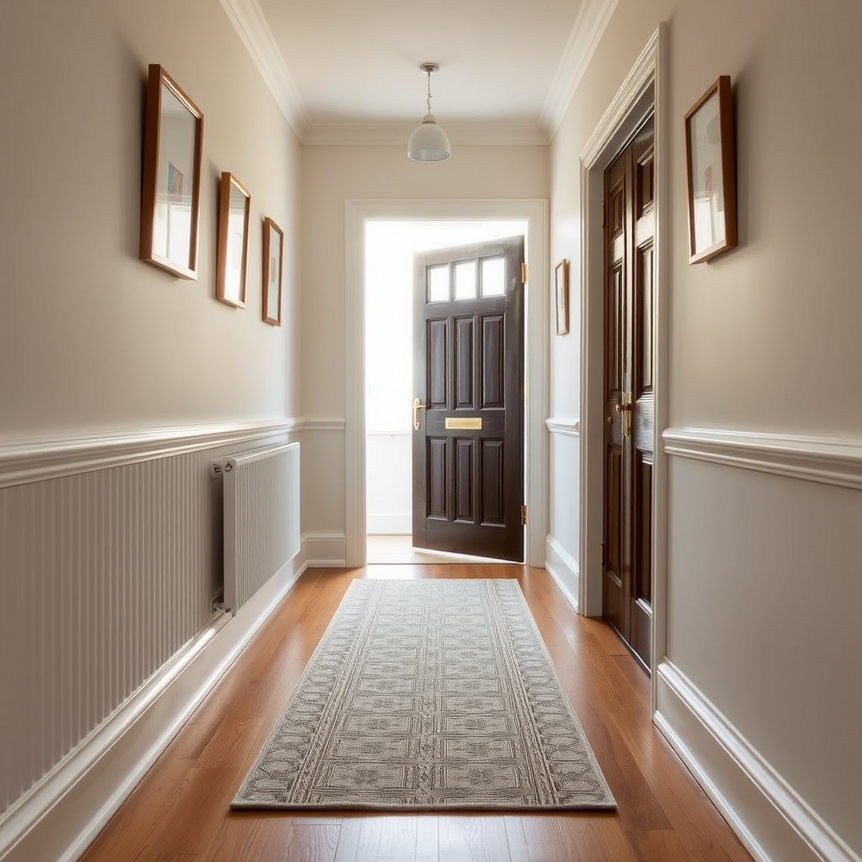Hallway runners add significant style and functionality to busy home corridors, serving as both a design element and a protective layer for your flooring. However, their high-traffic location means they are constantly exposed to dust, dirt, and wear, requiring targeted care to maintain their aesthetic appeal and structural integrity. Implementing a consistent maintenance routine is crucial not only for preserving their fresh appearance but also for extending their lifespan. By following these essential maintenance tips, you can ensure your hallway runner remains a welcoming and durable feature in your home year-round, coping with the rigours of everyday life and the unique challenges posed by the UK climate.
Why Regular Vacuuming Matters for Your Hallway Runner
Hallways endure constant foot traffic, making them magnets for dust, dirt, pet dander, and various debris. Regular vacuuming is the cornerstone of effective hallway runner maintenance. It doesn’t just maintain your runner’s fresh appearance; it also significantly prolongs its lifespan by preventing abrasive particles from embedding deep within the fibres, where they can cause premature wear and tear. Consistent vacuuming is key to preserving the structural integrity and aesthetic vibrancy of your rug.
Ideal Vacuuming Frequency for High-Traffic Areas
For busy hallways, especially those in family homes or homes with pets, vacuum your runner at least 2-3 times per week. This frequency is vital for preventing the buildup of dirt that can degrade carpet fibres over time. During wetter UK months, when mud and grit are more commonly tracked indoors, or if your hallway experiences exceptionally heavy use, daily vacuuming may be necessary. For runners in lower-traffic areas, such as guest hallways, a thorough weekly vacuuming often suffices to keep them clean and well-maintained.
Techniques to Prevent Damage While Vacuuming
To ensure effective cleaning without causing damage to your precious hallway runner, employ the following techniques:
- Use a vacuum with an adjustable-height setting. This allows you to raise the vacuum head slightly above the pile, preventing excessive pulling or fraying of delicate fibres, especially on shag or loop-pile runners.
- Avoid aggressive rotating brush heads on delicate, antique, or natural fibre runners (like wool or jute). These can snag, pull, and prematurely wear down fibres. Instead, opt for a suction-only mode or a vacuum attachment specifically designed for carpets.
- Vacuum in the direction of the runner’s pile. This helps to lift and remove dirt more effectively while also reducing the likelihood of excessive shedding and maintaining the pile’s natural orientation.
- Regularly clean and empty your vacuum cleaner’s filters and brushes. A clean vacuum maintains optimal suction efficiency, preventing the redistribution of dirt and ensuring that your efforts truly clean the rug.
Immediate Spot Cleaning Strategies to Preserve Runner Freshness
Accidents are an inevitable part of home life, especially in a busy hallway. Whether it’s a spilled drink or tracked-in mud, tackling spills promptly is paramount. Immediate spot cleaning can prevent stains from setting and stop lingering odours from permeating the fibres, preserving the overall freshness and appearance of your hallway runner.
How to Effectively Blot Spills Without Spreading Stains
The golden rule for spill management on any rug is to act immediately and blot, never rub. Here’s how to effectively manage spills:
- Act instantly by blotting the spill gently using a clean, white, absorbent cloth or paper towel. Coloured cloths may transfer dye to your runner.
- Avoid rubbing or scrubbing at all costs. Rubbing pushes the liquid deeper into the fibres and can spread the stain, making it larger and harder to remove.
- Work from the outer edges of the spill toward the centre. This technique helps to contain the liquid and prevents the stain from spreading outwards.
- Use multiple blotting cloths as they become saturated. Continue blotting until no more liquid transfers to the clean cloth.
Recommended Mild Cleaning Solutions and What to Avoid
Once the excess liquid is blotted, a mild cleaning solution can address any remaining residue:
- For most common stains, mix a few drops of mild dish soap or a dedicated carpet cleaner with warm water. This gentle solution is usually effective for food, drink, and general dirt marks.
- Always test any cleaning solution on an inconspicuous area of your runner first, such as a corner or an area usually hidden by furniture. This crucial step prevents unforeseen discoloration or damage to the fibres.
- Absolutely avoid bleach, ammonia, or any other harsh chemicals. These can severely damage the runner’s fibres, cause permanent fading, or even create a chemical residue that attracts more dirt over time.
- For stubborn or dried-on stains, a vinegar-water solution (a 1:3 ratio of white vinegar to water) can often safely lift marks. The acidity of vinegar helps break down many common stains, and the odour dissipates as it dries.
Deep Cleaning Approaches for a Thorough Hallway Runner Refresh
While regular vacuuming and immediate spot treatments are essential for daily maintenance, your hallway runner will periodically benefit from a deeper clean. This process helps to restore its vibrancy, remove embedded dirt and allergens that routine cleaning misses, and revitalise its overall appearance and texture.
DIY Methods: Using Baking Soda and Gentle Household Products
For an eco-friendly and effective deep clean, common household items can work wonders:
- Baking Soda Deodorisation: Sprinkle a generous, even layer of baking soda across your entire hallway runner. Let it sit for at least 15-30 minutes, or even overnight for strong odours. Baking soda is excellent at absorbing smells. Afterwards, vacuum thoroughly to remove the baking soda along with any trapped odours and fine dirt.
- Spot Treatment Paste: For more concentrated areas of dirt or lingering spots, create a gentle cleaning paste by mixing baking soda with a small amount of water. Apply this paste directly to the soiled area, allow it to sit for a few minutes, then gently agitate with a soft brush (like a toothbrush) before blotting clean with a damp cloth and vacuuming.
- Light Agitation: For general deep cleaning, use a soft-bristled brush or a carpet rake to lightly agitate the surface of the runner before vacuuming. This helps to loosen embedded dirt particles, making them easier for the vacuum to pick up.
Benefits of Steam Cleaning and When to Consider Professional Services
For a truly deep and sanitising clean, especially for runners made from synthetic or robust natural fibres, steam cleaning can be highly beneficial:
- Steam Cleaning Advantages: Steam cleaning (or hot water extraction) uses hot water and a cleaning solution, which is then extracted, taking dirt and grime with it. This method sanitises the rug without the need for harsh chemicals, making it ideal for homes with children, pets, or individuals with allergies. It is particularly effective for synthetic fibres that can withstand moisture.
- Considering Professional Cleaning: While DIY methods are great for maintenance, consider professional rug cleaning annually, or every six to eighteen months for high-traffic runners. Professionals have industrial-grade equipment that can achieve a much deeper clean and more thorough extraction, preventing moisture buildup that can lead to mould or mildew.
- Expertise for Delicate Runners: Professional cleaners are also adept at handling delicate runners or those made from natural materials like wool, silk, or antique fibres, which require specific cleaning agents and techniques to prevent shrinkage, colour bleeding, or damage. They can address stubborn stains and deep-seated odours that home methods might not fully resolve.
Enhancing Longevity: Choosing the Right Underlay for Your Hallway Runner
Beyond cleaning, one of the most impactful decisions you can make for your hallway runner’s longevity and performance is selecting an appropriate underlay. A quality underlay not only improves comfort underfoot but also acts as a critical protective barrier, significantly extending the life of your runner and enhancing safety by preventing slips and bunching.
Role of Underlays in Protection and Comfort
An effective underlay offers multiple benefits:
- Provides Cushioning: A good underlay adds a layer of cushioning underfoot, making the runner feel more luxurious and comfortable. This padding also absorbs impact, which reduces the direct stress on the runner’s fibres, thereby minimising wear and tear from foot traffic.
- Absorbs Impact & Prevents Movement: In busy walkways, an underlay absorbs the impact of footsteps, distributing the pressure more evenly. Crucially, it creates friction with both the floor and the runner, preventing the rug from slipping, bunching, or shifting, which is a common hazard in hallways.
- Protects Hard Flooring: Underlays form a protective barrier between your runner and the hard flooring beneath (wood, laminate, tiles). This prevents scratches, dents, or discolouration that can occur from the runner’s backing or trapped grit.
- Extends Runner Lifespan: By reducing friction, absorbing impact, and preventing slippage, an underlay significantly prolongs the life of your hallway runner, making it a wise investment in the long term.
Comparison Table of Popular Underlay Mats for Hallway Runners
Choosing the right non-slip underlay depends on your specific needs, the type of flooring, and the runner material. Here’s a comparison of common options:
| Underlay Material | Thickness (mm) | Price Range | Durability | Ideal Use |
|---|---|---|---|---|
| Felt | 5-7 | £10-20/m² | High | Natural fibres, comfort, sound absorption |
| Rubber | 3-6 | £8-18/m² | Very High | Non-slip, moisture-prone areas, hard floors |
| Foam | 5-10 | £7-15/m² | Moderate | Added cushioning, low-traffic areas, budget-friendly |
| Combination (Felt+Rubber) | 6-8 | £15-25/m² | Very High | Luxurious comfort, superior grip, all rug types |
For a truly stable and long-lasting hallway runner solution, a combination felt and rubber underlay often offers the best balance of durability, luxurious comfort, and superior non-slip stability. It’s an excellent choice for preventing movement in high-traffic hallways while protecting both your runner and your underlying flooring. Explore suitable options for your home here: Rugstars Non-Slip Hallway Runner & Door Mat.
Rotating and Repositioning: Simple Tactics to Even Out Wear
Hallway runners, by their nature, are exposed to concentrated foot traffic in specific areas, leading to uneven wear patterns. Simple tactics like rotating and repositioning your runner can significantly help in distributing this wear more evenly, extending its life and maintaining a consistent appearance across its surface.
How and When to Rotate Your Hallway Runner
- Frequency: Make it a habit to rotate your hallway runner 180 degrees every 3 to 6 months. This simple action ensures that the areas that typically receive the most footfall (e.g., the entry point or the middle of the hallway) are swapped with less-trafficked sections.
- Sunlight Exposure: For runners exposed to direct sunlight from windows or doorways, rotation is even more critical. It helps to prevent uneven fading, ensuring that the colours remain consistent across the entire rug.
- Benefits: Regular rotation contributes significantly to the overall longevity and uniform appearance of your hallway runner, preventing premature thinning or wear in specific spots.
Signs Your Runner Needs Repositioning or Replacement
Even with diligent care, all runners have a lifespan. Recognising the signs of significant wear or damage can help you decide when repositioning, professional intervention, or ultimately, replacement is necessary:
- Noticeable Thinning or Fraying: If you observe significant thinning, fraying, or bare spots in high-traffic pathways that don’t improve with rotation.
- Permanent Stains or Odours: Stains that resist multiple cleaning attempts or persistent, unpleasant odours indicate that the fibres may be permanently compromised or deeply soiled.
- Curling Edges or Movement: If the runner’s edges consistently curl, or if it frequently shifts and bunches despite having a suitable underlay, it might be losing its structural integrity or the underlay may need replacing.
- Diminished Appearance: If the runner simply looks tired, dull, or worn out, and deep cleaning no longer restores its aesthetic appeal.
If replacement is needed, consider investing in a durable, non-slip hallway runner designed for longevity and easy maintenance to ensure your next rug withstands the demands of a busy household.
Seasonal Care Tips Tailored for UK Weather Challenges
The UK climate, with its propensity for dampness, mud, and seasonal grit, poses unique challenges for hallway runners. Adapting your care routine to these seasonal variations is vital for maintaining your runner’s cleanliness, appearance, and longevity throughout the year.
Managing Moisture, Mud, and Winter Salt Residues
- Barrier Mats: Place robust, absorbent door mats just outside and inside all entry points. These act as a first line of defence, trapping moisture, mud, and grit before they reach your hallway runner. Look for mats with good scraping and absorption properties.
- Increased Vacuum Frequency: During wet autumn and winter months, increase your vacuuming frequency. This helps to manage the increased amount of tracked-in moisture and dirt, preventing it from embedding deeply and leading to mould, mildew, or a \”damp dog\” smell.
- Prompt Salt Removal: Winter often brings rock salt and de-icing chemicals onto shoes. These residues can be highly corrosive to rug fibres and may leave white marks. Promptly remove any visible salt with a dry brush or vacuum, then follow with a mild soap and water solution (tested first) if a residue remains. Blot thoroughly to avoid oversaturation.
Preventive Measures to Maintain Runner Appearance Year-Round
- Moisture-Resistant Underlay: Install a suitable underlay with moisture-resistant properties. While no underlay is fully waterproof, some offer a barrier that protects the floor beneath from incidental moisture that might seep through the runner.
- Professional Cleaning Schedule: Consider scheduling professional hallway runner cleaning before and after the most challenging seasons (e.g., late autumn before winter sets in, and early spring once the worst of the weather has passed). This ensures a deep clean to remove accumulated grime, allergens, and salt residues.
- Shoe-Free Zones: Where possible, encourage family members and guests to remove shoes before walking on the hallway runner. This dramatically reduces the amount of dirt, grit, and moisture tracked onto the rug, significantly preserving its appearance and cleanliness.
- Ventilation: Ensure good ventilation in your hallway, especially during damp periods, to help any moisture evaporate quickly and prevent musty odours.
By implementing these strategies, you can ensure your hallway runner remains a stylish, hygienic, and durable feature in your home, effectively coping with the rigours of UK living and the demands of a busy household.
Frequently Asked Questions About Hallway Runner Maintenance
How often should I deep clean my hallway runner?
Deep cleaning is recommended once or twice per year, depending on foot traffic and household activity. Regular spot cleaning and vacuuming should be performed in between deep cleans.
Can I use bleach or strong detergents on my runner?
No. Bleach, ammonia, and other harsh chemicals can cause irreversible fibre damage, fading, and deterioration. Always use mild, pH-neutral detergents or specific carpet cleaning solutions, and test them on an inconspicuous area first.
What is the best underlay material for durability and comfort?
A combination felt and rubber underlay generally provides the best balance of cushioning, durability, superior non-slip grip, and protection for both your runner and underlying flooring.
How do I remove stubborn stains without damaging fibres?
Act quickly by blotting spills immediately. For remaining stains, use a mild solution of dish soap and water or a vinegar-water solution (1:3 ratio), always testing on a hidden spot first. Avoid rubbing. For very stubborn or unknown stains, it’s best to consult professional rug cleaners.
Should I hire professionals for regular runner maintenance?
While diligent home care covers most needs, professional cleaning annually (or every 6-18 months for high-traffic areas) ensures deep sanitisation, thorough dirt extraction, and expert fibre care, especially for high-value or delicate runners.
For top-quality, non-slip hallway runners that pair perfectly with expert care, visit Rugstars to explore our extensive collection tailored for the demands of modern homes.



